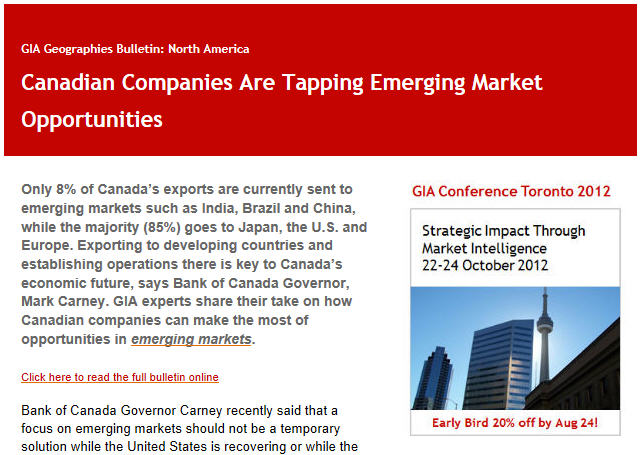
Subject: GIA Bulletin: Canadian Companies Are Tapping Emerging Market Opportunities
|
|
|
|
|
|
GIA Geographies Bulletin: North America
Canadian Companies Are Tapping Emerging Market Opportunities |
|
|
|
|
|
|
Only 8% of Canada’s exports are currently sent to emerging markets such as India, Brazil and China, while the majority (85%) goes to Japan, the U.S. and Europe. Exporting to developing countries and establishing operations there is key to Canada’s economic future, says Bank of Canada Governor, Mark Carney. GIA experts share their take on how Canadian companies can make the most of opportunities in emerging markets.
Bank of Canada Governor Carney recently said that a focus on emerging markets should not be a temporary solution while the United States is recovering or while the Canadian dollar is high. He considers it a long-term solution. “Emerging markets represent the greater opportunity for Canadian exporters. Since the recession, these economies have accounted for roughly two-thirds of global economic growth and one-half of the growth in global imports,” said Carney. He thinks that the opportunity for growth in the “post-crisis world” lies in these rising markets.
What’s holding Canadian companies back?
Carney blames Canada’s “deteriorating export performance” on what he believes to be a combination of overexposure to the U.S. markets and underexposure to faster-growing emerging markets - a belief that is shared by Prime Minister Stephen Harper, who said “For us, the United States cannot be our only export market. That is not in our interest.” According to Statistics Canada, North America accounted for 76.1% of Canada’s exports in 2010, down from 87.1% in 2001. During that same time period, the share of exports going to Asia and Europe nearly doubled.
“When speaking to Canadian companies that are interested in international trade, we often hear that the U.S. is a market that they know about, they understand, and they know how to engage in business with” says Rahul Dhingra, Senior Consultant at GIA North America.
“However, when it comes to looking beyond the U.S., Canadian firms are more hesitant because the nature of those markets is simply unknown to them. For example, we hear questions and comments such as: “How do we determine the price benchmarks for our products in Latin America?” “We want to understand what the local and international competition is in Brazil before we decide to enter that market.” “We know this type of work is performed in China, but how do we find the best resources there?” Gathering information about the competitive landscape, the best approach to market entry and finding the most appropriate international trade partners can help to reduce the ambiguity, and therefore the risk, for Canadian firms investing in trade with emerging markets,” continues Dhingra.
| |
Latest Publications
WHITE PAPER
Business Perspectives (US Results) on Emerging Markets 2012-2017
BULLETIN
The 10 Commandments for Developing Competitor Battle Cards
BOOK
The Handbook of Market Intelligence
New!
MEET GIA EMERGING MARKETS EXPERTS
Navigating Emerging Markets Takes An Expert Hand
|
|
|
|
|
About GIA Bulletins
GIA bulletins offer complimentary views, analysis and thought-leadership on industries, geographies and market intelligence. You are receiving this because we have previously discussed your market intelligence needs. It is also possible that someone else submitted your details. We respect your privacy and welcome you to indicate your mailing preference below. Thank you.
|
|
|
|

